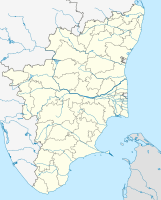
Photo from wikipedia
Buried channels are the subsurface geomorphic features, which illustrate the pattern and evolution of paleodrainage system in an area. Old topographical map (1967) of Kottumangalam coast of southwest Tamil Nadu,… Click to show full abstract
Buried channels are the subsurface geomorphic features, which illustrate the pattern and evolution of paleodrainage system in an area. Old topographical map (1967) of Kottumangalam coast of southwest Tamil Nadu, India, revealed that surface channel was directly drained into the sea, but in the present situation the same channel is not depicted on maps which indicate the channel has buried. The present study is focused to identify the location and architecture of modern buried channels through ground-penetrating radar (GPR) technology in study area. The study place is highly influenced by natural events (tsunami, high tide flood, and storm), southwest monsoon, and high waves. A 200-m-long subsurface profile was generated using GPR survey parallel to the coast. Geophysical (amplitude, attenuation, magnitude), geological (channel bed, channel bank, erosional surface, volume of sedimentation), and geographical (old topographical map) evidence were considered to identify and locate the paleochannels and to understand their developments at different stages. Two buried channels (at 120–136 m and 184–200 m in the GPR profile) were traced in between 0.5 and 3.2 m depth and it portrays three stages of evolution. High amplitude reflection and dipping of sedimentary beds in the channel banks are the notable signatures of paleochannel in the study area. Flat attenuation curves and velocity differences in the zone of the buried channels disclosed the presence of buried channels. The channels were buried due to changing conditions of marine, aeolian, and fluvial processes. Five distinct sedimentary layers, as shown by variance of reflections of radar wave from subsurface sand material at various depths are recognized as (i) saturated, (ii) semi-saturated, (iii) compact, (iv) transition, and (v) recent upper layer, besides that two erosional surfaces (around 0.8 and 1.5 m depth) were identified. The current study provides a better understating of mapping and identifying the occurrences of paleochannels in coastal environment using GPR technology.
Journal Title: Arabian Journal of Geosciences
Year Published: 2020
Link to full text (if available)
Share on Social Media: Sign Up to like & get
recommendations!